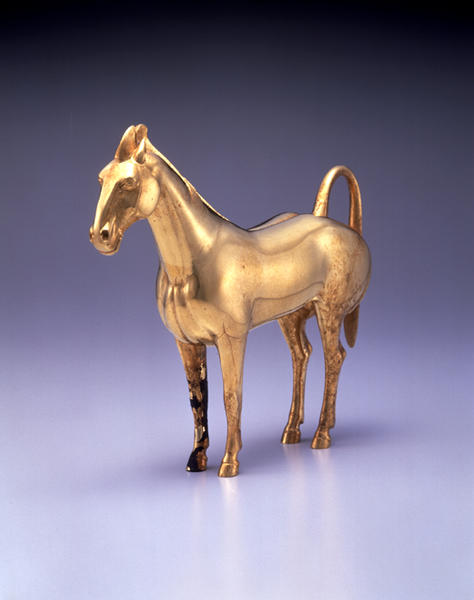馬小像
- 中国
- 中国・前漢時代
- 紀元前2世紀
- 金
- H-25.4 D-6.3 W-30.9
作品解説(長安 陶俑の精華)
馬
金
前漢時代
高25.4cm 幅30.9cm 奥行6.3cm
MIHO MUSEUM
のびやかな馬の肢体を写実的な手法で捉えている。スラリと伸びる四肢と厚い胸、逞しい臀部の肉付きはこの馬の走力の高さを伝えており、前方に伸ばした長い頸と頸の付け根に見える盛り上がったき甲は、この馬が始皇帝の兵馬俑の馬とは別種の、新たに西方からもたらされた馬を写していることを示している。同様に写実的な馬の表現は、1981年5月、茂陵陪葬墓のうち最大の封土をもつ無名塚周辺の陪葬坑の一つから発見された銅製鍍金の馬(高62cm、長76cm)にも見られる。この無名塚は出土した銅器の多くに「陽信家」の刻銘があるところから、衛青と再婚して元封元年(前110)頃亡くなった武帝の姉・陽信長公主の墓と考えられている。
茂陵に葬られた武帝は良馬を求めて大宛(フェルガナ)に大遠征を起こし、太初4年(前101)にもたらされた馬が烏孫の馬よりも優れていることに感激し、それまで烏孫の馬に与えていた「天馬」の名をこれに与え、烏孫の馬には新たに「西極馬」の名を与えたことで知られている。
ところでこの馬の表現をよく見ると、鼻梁が外に張り出す兎頭の顔、長めの胴体、一度盛り上がり臀部に向けて下降線を描く腰、尾の付け根から大きく後方に突き出している臀部の形状などの特色は図版2の騎兵の馬や、図版9の馬俑の特色と一致していることに気づく。黄金の馬についてはその重量が7キログラムで、およそ30斤、かなり正確に当時の1鈞の単位に一致することが指摘されており、このことから武帝が大宛遠征に先立ち、良馬獲得の交渉のために千金とともに使者に持たせた黄金の馬との関係が連想されている。もしもこの黄金の馬と図版2、9の馬俑に共通する特色が、大宛馬に先んじて漢にもたらされたという烏孫馬の特色を再現していると考えることができるならば、この連想を補強することになるだろう。
ちなみにこの馬の長い頸、高いき甲、長めの胴体という形態的な特色は、かつての大宛国の西部地方にあたる現在のトルクメニスタンの名馬アハルテケに通じており、これが大宛馬に近い系譜を備えていたことを伝えてくれる。
Catalogue Entry(2004)
Horse
Gold
Western Han dynasty
H. 25.4cm, W. 30.9cm, Depth 6.3cm
Miho Museum
The long limber form of this horse is shown realistically. The staunchly extended legs, thick chest, muscular haunches all convey the horse’s power. The long neck, extended forward, and forelock, swept back, all reveal a horse form from the west, unlike the horse figurines found at emperor Shi Huangdi’s tomb. This same kind of realistic horse expression can be found in a gilt bronze horse (height 62 cm, length 76 cm) discovered in May 1981 in one of the subsidiary trenches in the vicinity of Wumingzhong, the largest domain among all the subsidiary tombs of the Maoling tomb. The majority of the bronzes excavated from this Wumingzhong site were inscribed Oyangxinjia,O and thus it is thought that this was the tomb of Princess Yangxinchang, sister of emperor Wu, who died around Yuanfeng 1 (110 BC) after her remarriage to Weiqing.
Emperor Wudi, buried at Maoling, sent ambassadors to Ferghana (Dayuan) in search of good horses. He was impressed by the horses that he received in Taichu 4 (101 BC) from that search, were superior to Wusun horses. This led the emperor to give the Otianma,O or celestial horse, designation to the Ferghana horses, switching it from the previous designation of Wusun horses by that name. He renamed the Wusun horses, Oxijima.O
However, close examination of this horse reveals that it has a ram-head with flaring nostrils, long torso, raised haunches with descending back line, and high tail placement. These characteristics can also be seen on the horses at cat. No. 2 and cat. No. 9. This gold horse weighs approximately 7 kilograms, which is approximately 30 yin, or about a single unit of the jun measure used during that period. We can thus consider that there might be some connection between this gold horse, and the gold horse and the 1,000 gold pieces sent with the emperor’s emissary to use in exchange for the horses before his military campaign in Ferghana. If we were to consider that this gold horse, and those seen at cat. Nos. 2 and 9 are representative of the characteristics of the Wusun horses who were in China before the Ferghana horses, this connection might be considered all the stronger.
These characteristics, the long neck, high forelock, long torso, etc., also reflect the features of the Akhal-Take horse which is famous in the Turkmenistan region today, or the western region of ancient Ferghana. This horse’s features are similar to those of the Ferghana horses.
